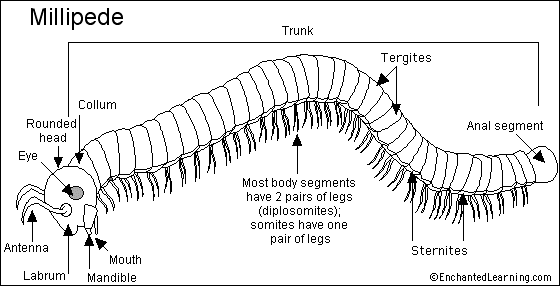
Millipede |

Millipedes live on land in moist microhabitats (under rocks, in rotting logs, in leaf debris, or occasionally in burrows).
Anatomy: Millipedes have a segmented body, short antennae, and many legs. Most body segment have two pairs of legs that stick out from the sides of the body (each segment is really 2 segments fused together). The segments that have two pair of legs are called diplosomites. The first few segments have only one pair of legs; they are called somites. The second-to-last segment has no legs. The last segment is called the anal segment; it is where waste (in the form of pellets) leaves the body. Most millipedes have from 25 to 100 segments (47 to 197 pairs of legs). The legs move in a wave-like motion.
The body is divided into two parts, the head and a segmented trunk. Millipedes breathe through spiracles, holes positioned in paris along the body. The top of each segment is called the tergite (or tergum); the underside (between the pairs of legs) is called the sternite (or sternum). Millipedes have poor to no vision. Millipedes range in size from a fraction of an inch to about 9 inches (23 cm) long.
Diet: Most millipedes are herbivores (plant-eaters) that eat dead and decaying plant material, but a few are also carnivores (meat-eaters). Millipedes also occasionally eat moist, living plants. They are often nocturnal (more active at night).
Enemies: Birds, badgers, and shrews eat millipedes. When they are in danger, millipedes curl up in a spiral, protecting their soft undersides. They can also spray a bad-smelling liquid (hydrocyanic acid) that repels many predators.
Reproduction: Millipedes hatch from eggs - hatchlings have only the first three pairs of legs. There is some maternal care of the eggs. Millipedes molt (shed their old exoskeleton) as they grow - with each molt they gain more segments and legs.
Classification: Kingdom Animalia (animals), Phylum Arthropoda (jointed legs and an exoskeleton), Superclass Myriapoda ("many-footed" with a 2-segmented body - millipedes, centipedes, etc.), Class Diplopoda (millipedes). About 7,500 species of millipedes have been described.